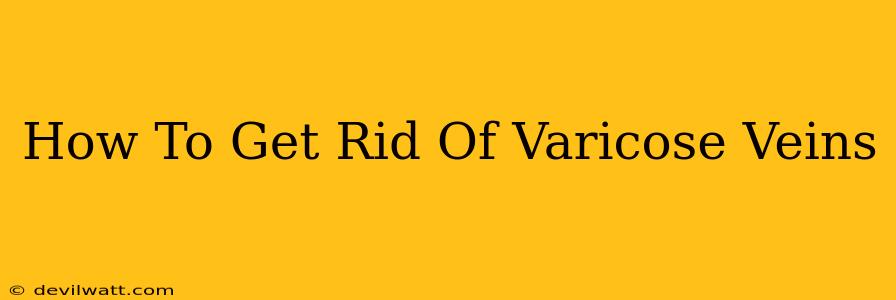Varicose veins, those unsightly, bulging veins often appearing on the legs and feet, are a common condition affecting millions. While they might seem purely cosmetic, varicose veins can cause discomfort, pain, and even more serious health issues if left untreated. This comprehensive guide explores various methods to get rid of varicose veins, helping you choose the best approach for your individual needs.
Understanding Varicose Veins: Causes and Symptoms
Before diving into treatment options, it's crucial to understand the root cause of varicose veins. They develop when the valves in your veins weaken, allowing blood to flow backward and pool, causing the veins to swell and become visible. Several factors contribute to their development, including:
- Genetics: A family history of varicose veins significantly increases your risk.
- Age: The risk increases with age as vein valves naturally weaken over time.
- Gender: Women are more likely to develop varicose veins than men.
- Pregnancy: Hormonal changes and increased blood volume during pregnancy put extra pressure on leg veins.
- Obesity: Excess weight adds more pressure on your veins.
- Prolonged Standing or Sitting: Limited movement restricts blood flow and increases venous pressure.
Common Symptoms of Varicose Veins:
- Visible, bulging veins: This is the most noticeable symptom, often appearing blue or purple.
- Aching or heavy feeling in the legs: This discomfort is often worse after prolonged standing or sitting.
- Leg swelling: Fluid buildup can cause swelling, especially in the ankles and feet.
- Burning or cramping in the legs: These sensations can be quite uncomfortable.
- Skin changes around the veins: The skin may become discolored, itchy, or even ulcerated in severe cases.
Effective Treatments for Varicose Veins
Several treatment options are available, ranging from conservative measures to more invasive procedures. The best approach depends on the severity of your varicose veins and your overall health.
1. Lifestyle Changes: The First Line of Defense
Before considering medical interventions, adopting healthy lifestyle habits can significantly improve vein health and reduce symptoms:
- Regular Exercise: Regular physical activity, especially walking, improves blood circulation.
- Weight Management: Losing weight reduces pressure on your veins.
- Elevation of Legs: Elevating your legs above your heart several times a day can help reduce swelling.
- Compression Stockings: Compression stockings provide gentle pressure to support blood flow and reduce swelling. Consult a doctor to determine the appropriate compression level.
- Avoid Prolonged Standing or Sitting: Take regular breaks to move around and improve circulation.
2. Medical Treatments: When Lifestyle Changes Aren't Enough
If lifestyle changes aren't sufficient, various medical treatments can effectively eliminate or minimize varicose veins:
- Sclerotherapy: This minimally invasive procedure involves injecting a solution into the affected veins, causing them to collapse and fade.
- Endovenous Laser Ablation (EVLA): This procedure uses laser energy to close off the affected veins.
- Radiofrequency Ablation (RFA): Similar to EVLA, RFA uses radiofrequency energy to seal off the veins.
- Phlebectomy: This minimally invasive surgical procedure removes small varicose veins through tiny incisions.
- Surgical Ligation and Stripping: This more invasive procedure is usually reserved for severe cases.
Choosing the right treatment: Your doctor will assess your condition and recommend the most appropriate treatment based on factors like the size and location of your varicose veins, your overall health, and your personal preferences.
Preventing Varicose Veins
While genetics play a role, you can take steps to reduce your risk of developing varicose veins:
- Maintain a healthy weight.
- Engage in regular exercise.
- Elevate your legs regularly.
- Wear compression stockings if necessary.
- Avoid prolonged standing or sitting.
When to See a Doctor
It's crucial to consult a doctor if you experience any symptoms of varicose veins, especially if they are causing pain, swelling, or skin changes. Early intervention can help prevent complications and improve treatment outcomes. Don't hesitate to seek professional medical advice for a proper diagnosis and personalized treatment plan. Early detection and treatment can significantly improve your comfort and overall well-being.

